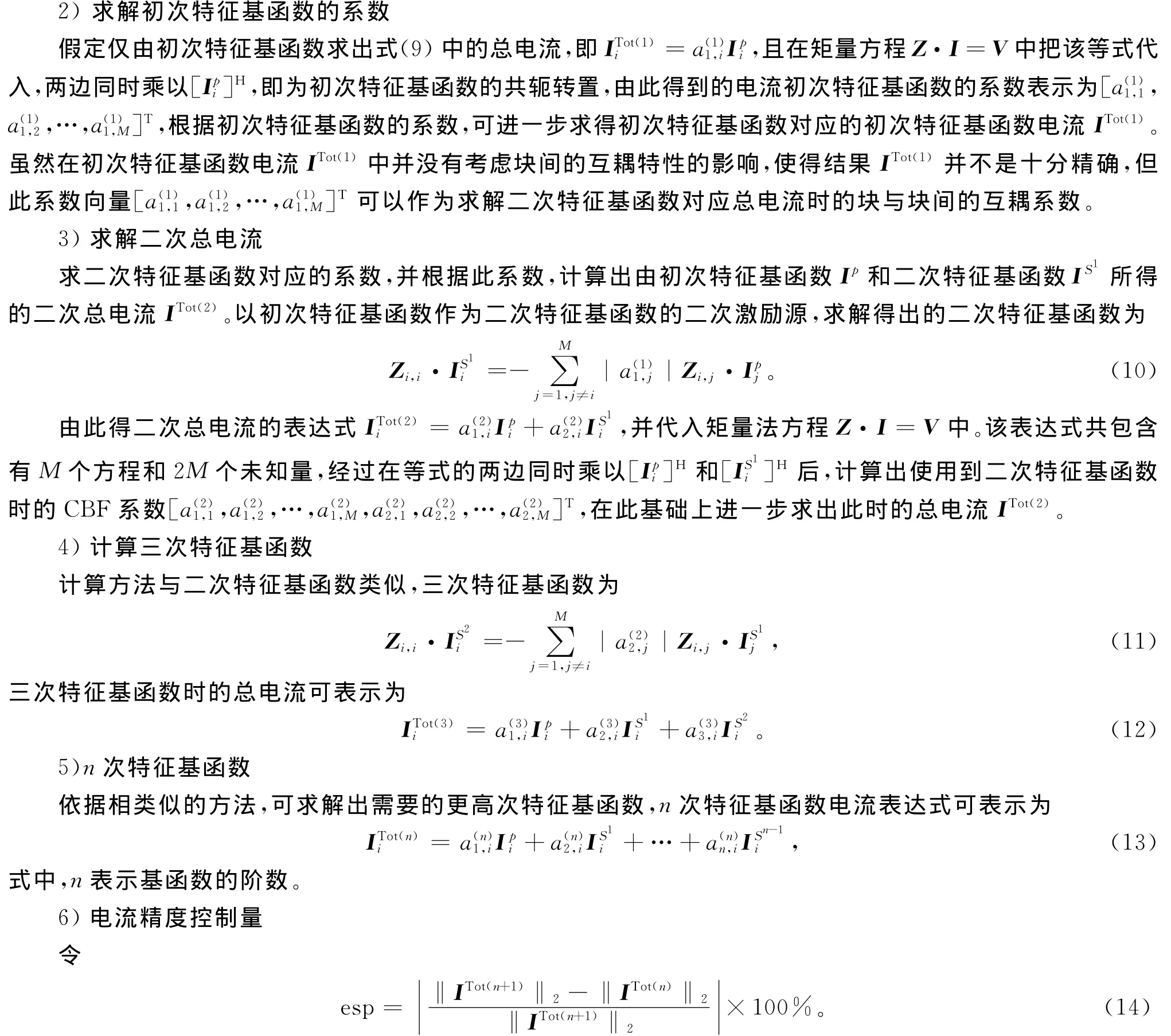AMCBFM分析微带天线阵列的电磁散射
高 荣,胡 庆,袁家德
(1.成都电子机械高等专科学校,四川成都 611730;2.成都大学电子信息工程学院,四川成都610106;3.福州大学物理与信息工程学院,福建福州 350108)
AMCBFM分析微带天线阵列的电磁散射
高 荣1,胡 庆2,袁家德3
(1.成都电子机械高等专科学校,四川成都 611730;2.成都大学电子信息工程学院,四川成都610106;3.福州大学物理与信息工程学院,福建福州 350108)
用自适应修正特征基函数法(AMCBFM)分析微带天线的电磁散射特性。以矩量法和体面积分方程为基础,把微带天线介质部分用四面体网格剖分,对应于SWG基函数;微带天线导体部分用三角形网格剖分,对应于RWG基函数。分析了2×2微带天线阵列的单站RCS和7×7微带天线阵列的双站RCS。结果表明:AMCBFM能有效分析微带天线阵列的电磁散射特性,且具有大幅度降低阻抗矩阵大小、减少计算机内存需求等优点。
矩量法;体面积分方程;自适应修正特征基函数方法;微带天线
电磁场全波分析模型中基于积分方程的矩量法在计算电磁学中有着越来越广泛的应用。但随着待分析目标电尺寸的增加,传统矩量法需要的存储量和计算量也将急剧上升,为此人们提出并着手研究出了多种方法来减少矩量法的计算时间和降低内存需求。常用的基于矩量法的快速算法有预校正-快速傅里叶变换(PFFT)[1-2]、快速多极子法(FMM)、多层快速多极子法(MLFMM)[3-5]、共轭梯度-快速傅里叶变换法(CGFFT)[6-7]、自适应积分法(AIM)[8-10]和特征基函数法(CBFM)[11-12]等。目前,各种快速算法都已经在目标体的电磁特性数值分析中得到了不同程度的应用。
相比于特征基函数法(CBFM 自适应修正特征基函数法(AMCBFM 应用一种新的精度判断方法来便捷地控制电流误差,以此判断是否需要计算更高次的基函数,这样可以更有效控制计算精度及提高计算效率。AMCBFM已经在基于面积分方程矩量法中得到了越来越广泛的应用[13-16]。在此基础上,笔者将AMCBFM应用于基于体面积分方程矩量法,并用该方法具体分析了微带天线阵列的散射特性,其中,微带天线介质区域用四面体网格剖分,对应于SWG基函数;微带天线导体区域用三角形网格剖分,对应于RWG基函数。
1 理论分析
1.1 体面积分方程
设有一任意形状的理想导体目标,其表面用S表示,一个介电常数为ε(r)的各向同性介质目标体,其所占空间体积用V表示。设入射到介质金属混合目标体上的均匀平面电磁波电场的电场强度为E i(r),则在理想导体表面S和介质体V内总电场分别应满足边界条件:

在介质区域体内采用文献[17]提出的四面体剖分及对应的SWG基函数将电通量展开;金属表面电流采用文献[18]提出的基于三角形面元的RWG矢量基函数展开,然后再采用伽略金法选配,即可得到矩量法阻抗矩阵并求解。
1.2 AMCBFM
采用AMCBFM[13]把介质金属混合目标体分成M块,并分别在每个子块上求解出初次特征基函数I p,根据初次特征基函数再求解出反映子块与子块间相互作用关系的高次特征基函数I s,进而得到电流的数学表达式,具体步骤如下。
1)计算初次特征基函数I p

式中:V i为第i块的初始激励;Z i,i为第i块内的自阻抗。

当esp即电流精度控制量达到预定精度后即可停止计算更高阶的特征基函数,否则转向第5)步。
2 实验结果分析
2.1 微带天线2×2阵列
微带天线结构尺寸为W=14 mm,L=9.6 mm,Wg=Lg=60 mm,h=0.8 mm,a=b=15 mm,如图1所示,且相对介电常数εr=4.34。按照本文的方法将微带天线离散为2 401个四面体单元,则共生成1 754个边界面、1 308条公共边和3 925个公共面,共含有未知量6 987个。入射的平面波的频率为f=5.02 GHz。
在AMCBFM中,目标体共被分成了4块,电流精度控制量esp取0.03,即计算到三阶基函数就可达到精度要求。由于目标体被剖分生成的网格较多,如果用传统矩量法则无法直接计算。用AMCBFM求出俯仰角θ为0°~90°的单站RCS,给出了数值计算结果,并与文献[19]的计算结果进行分析对比,如图2所示。从图2可以观察出结果吻合得较好,这表明了用本文的网格模型和AMCBFM分析微带天线阵列电磁散射特性是可靠的。用AMCBFM方法进行分析时,经测试所需的最大内存需求为338.264 MB。
2.2 微带天线7×7阵列
天线结构模型的结构及参数描述仍如图1所示,结构尺寸分别为W=20 mm,Wg=250 mm,L=30 mm,h=1.6 mm,Lg=260 mm,a=4.5 mm,b=14.5 mm,相对介电常数取εr=2.55。则天线阵列被离散成19 301个四面体,共生成公共面31 960个、边界面13 284个和公共边13 956个,共含有59 200个未知量。取入射的平面波的频率f=4.35 GHz。

该目标体被剖分的网格较多,用传统矩量法同样无法直接计算。在AMCBFM中,该目标体被分成49块,其中天线贴片自然分块,接地面通过块间重叠来保持电流的连续性[12]。esp取0.04,计算到二阶基函数即可达到精度要求。计算结果如图3所示。用AMCBFM计算时,计算时间仅需51 499 s,测试的最大内存仅需755.368 MB。
3 结 语

图3 平面微带天线7×7阵列的θθ极化双站RCSFig.3 Bistatic RCS(θθpolarization)of microstrip antenna with 7×7 array
在体面积分方程矩量法的基础上,将自适应修正特征基函数方法应用于分析微带天线阵列的电磁散射特性。与传统的矩量法相比,该方法在保证计算精度的同时,不仅计算时间短,而且大大节约了存储量,为用矩量法计算电尺寸微带天线阵列提供了一种行之有效的途径,大大提高了其工程实际应用价值。
[1]OKHMATOVSKI V,YUAN M,JEFFREY I,et al.A three-dimensional precorrected-FFT algorithm for fast method of moments solutions of the mixed-potential integral equation in layered media[J].IEEE Transactions on Microwavetheory and Techniques,2009,57(12):3 505-3 517.
[2]PHILLIPS J R,WHITE J K.A precorrected-FFT method for electrostatic analysis of complicated 3-D structures[J].IEEE Trans Computer-Aided Design Integr Circuits Syst,1997,16(10):1 059-1 072.
[3]VANDE G D,MICHIELSSEN E,OLYSLAGER F,et al.A high-performance upgrade of the perfectly matched layer multilevel fast multipole algorithm for large planar microwave structures[J].IEEE Transactions on Antennas and Propagation,2009,57(6):1 728-1 739.
[4]LING F,SONG J,JIN J M.Multilevel fast multipole algorithm for analysis of large-scale microstrip structures[J].IEEE Microwave and Guided Wave Letters,1999,9(12):508-510.
[5]SERTEL K,VOLAKIS J L.Multilevel fast multipole method solution of volume integral equations using parametric geometry modeling[J].IEEE Transactions on Antennas and Propagation,2004,52(7):1 686-1 691.
[6]WANG C F,XIA L,LI L W,et al.BCG-FFT analysis of microstrip structure in multilayered media[A].Asia-Pacific Microwave Conference(APMC)[C].Taipei:[s.n.],2001.212-215.
[7]SARKAR T K,ARVAS E,RAO S M.Application of FFT and the conjugate gradient method for the solution of electromagnetic radiation from electrically large and small conducting bodies[J].IEEE Transactions on Antennas and Propagation,1986,34(5):635-640.
[8]MO L,RUI P L,ZHUANG W,et al.Fast analysis of microstrip antenna array by use of the adaptive integral method(AIM)combined with the loose GMRES method[J].IEEE Antennas and Propagation Society International Symposium,2005,53(2):479-482.
[9]GUO J L,LI J Y,LIU Q Z.Analysis of arbitrarily shaped dielectric radomes using adaptive integral method based on volume integral equation[J].IEEE Transactions on Antennas and Propagation,2006,54(1):1 910-1 916.
[10]LING F,WANG C F,JIN J M.An efficient algorithm for analyzing large-scale microstrip structures using adaptive integral method combined with discrete complex-image method[J].IEEE Transactions on Microwave Theory and Techniques,2000,48(5):832-839.
[11]YEO J,PRAKASH V V S,MITTRA R.Efficient analysis of a class of microstrip antennas using the characteristic basis function method(CBFM)[J].Microwave and Optical Technology Letter,2003,36(6):456-464.
[12]YEO J,PRAKASH V V S,MITTRA R.Characteristic basis function method:A new technique for efficient solution of method of moments matrix equations[J].Microwave and Optical Technology Letters,2003,36(2):95-100.
[13]HAN Guo-dong,GU Chang-qing.A hybrid QR factorization with dual-MGS and adaptively modified characteristic basis function method for electromagnetic scattering analysis[J].Microwave and Optical Technology Letters,2007,49(11):2 879-2 883.
[14]韩国栋,潘宇虎,何丙发,等.AMCBFM-MBPE快速分析三维目标的宽带宽角散射特性[J].微波学报(Journal of Microwaves),2009,25(6):32-37.
[15]韩国栋,顾长青.QR-AMCBFM技术快速分析电磁散射特性[J].电子科技大学学报(Journal of University of Electronic Science and Technology of China),2008,37(6):879-882.
[16]韩国栋,顾长青.电磁散射研究中的自适应修正特征基函数法[J].电子与信息学报(Journal of Electronics &Information Technology),2008,30(10):2 364-2 368.
[17]SCHAUBERT D H,WILTON D R,GLISSON A W.A tetrahedral modeling method for electromagnetic scattering by arbitrary shaped inhomogeneous dielectric bodies[J].IEEE Transactions on Antennas and Propagation,1984,32(1):77-85.
[18]RAO S M,WILTON D R,GLISSON A W.Electromagnetic scattering by surfaces of arbitrary shape[J].IEEE Transactions on Antennas and Propagation,1982,30(3):409-417.
[19]YUAN Ning,YEO T S,NIE Xiao-chun,et al.Analysis of probe-fed conformal microstrip antennas on finite grounded substrate[J].IEEE Transactions on Antennas and Propagation,2006,54(2):554-561.
Analysis of electromagnetic scattering of micro-strip antenna array by using AMCBFM
GAO Rong1,HU Qing2,YUAN Jia-de3
(1.Chengdu Electromechanical College,Chengdu Sichuan 611730,China;2.School of Electronic and Information Engineering,Chengdu University,Chengdu Sichuan 610106,China;3.College of Physics and Information Engineering,Fuzhou University,Fuzhou Fujian 350108,China)
Electromagnetic scattering characteristics of the microstrip antenna array is analyzed by using the adaptively modified characteristic basis function method(AMCBFM).Volume electric field integral equation and SWG basis function are applied to the material region,while the surface electric field integral equation and RWG basis function are applied on the conducting surface of the microstrip antenna array.The method of moments(Mo M)is used to convert the integral equation into a matrix equation.The bistatic RCS of 7×7 microstrip antenna array and the monostatic RCS of 2×2 microstrip antenna array are analyzed numerically.The results indicate that the proposed method has a series of merits:reducing the size of the matrix equation into a small level and saving the memory requirments.
method of moments(Mo M);volume-surface integral equation;AMCBFM;micro-stripantenna
TN82
A
1008-1542(2012)04-0330-04
2012-03-07;责任编辑:李 穆
福建省自然科学基金资助项目(2011J01348)
高 荣(1969-),女,山西大同人,讲师,硕士,主要从事微波电磁场等方面的研究。

